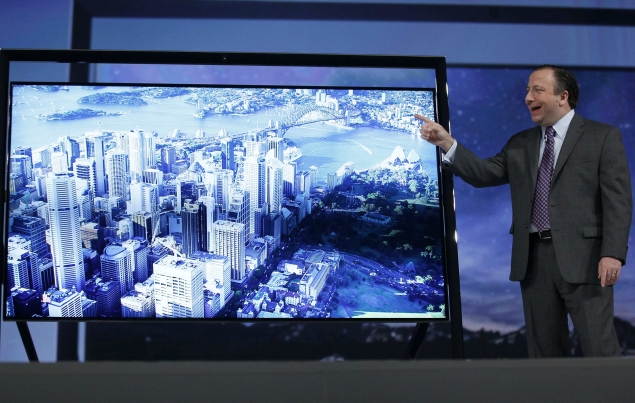Samsung, LG unveil super-thin, curved OLED TVs

Considered the future of consumer electronics displays, the OLED technology is more energy-efficient and offers higher-contrast images than liquid crystal display, and is so thin that future mobile devices will be able to fold like paper.
The panels use an organic chemical compound as a key material which emits light in response to an electric current.
Both Samsung and its rival LG unveiled 55-inch OLED TV a year ago at the Consumer Electronics Show in Las Vegas, and this year they advanced their technology with a curved panel, which allows the distance between the user and TV screen to be the same from any angle.
LG, now the sole seller of the next-generation technology, marched ahead by taking orders for OLED TVs last week. They will not be available for delivery until February.
Samsung said it plans to launch both curved and flat OLED TVs in the first half of this year.
Due to high production costs, OLED TV is expected to take a fraction of the global TV market for the next two to three years. LG is selling its 55-inch OLED model for $10,300 (11 million won).
Japan's Panasonic Corp, in a display of technological one-upmanship with its South Korean rivals, unveiled a prototype of 56-inch OLED screen, only an inch bigger than ones unveiled by Samsung and LG at the CES on Tuesday.
© Thomson Reuters 2012
In pics: Best of CES 2013
For the latest tech news and reviews, follow Gadgets 360 on X, Facebook, WhatsApp, Threads and Google News. For the latest videos on gadgets and tech, subscribe to our YouTube channel. If you want to know everything about top influencers, follow our in-house Who'sThat360 on Instagram and YouTube.
Related Stories
- Amazon Great Indian Festival 2024
- Big Billion Days 2024
- Apple Vision Pro
- Oneplus 12
- iPhone 14
- Apple iPhone 15
- OnePlus Nord CE 3 Lite 5G
- iPhone 13
- Xiaomi 14 Pro
- Oppo Find N3
- Tecno Spark Go (2023)
- Realme V30
- Best Phones Under 25000
- Samsung Galaxy S24 Series
- Cryptocurrency
- iQoo 12
- Samsung Galaxy S24 Ultra
- Giottus
- Samsung Galaxy Z Flip 5
- Apple 'Scary Fast'
- Housefull 5
- GoPro Hero 12 Black Review
- Invincible Season 2
- JioGlass
- HD Ready TV
- Laptop Under 50000
- Smartwatch Under 10000
- Latest Mobile Phones
- Compare Phones
- Vivo Y300 5G
- Red Magic 10 Pro+
- Red Magic 10 Pro
- Asus ROG Phone 9
- Asus ROG Phone 9 Pro
- ZTE Blade V70
- Vivo Y18t
- Honor X9c
- Asus Zenbook S 14
- MacBook Pro 16-inch (M4 Max, 2024)
- Huawei MatePad 11.5
- Acer Iconia Tab 10.36 (iM10-22)
- Redmi Band 3
- Xiaomi Smart Band 9 Pro
- Sony 65 Inches Ultra HD (4K) LED Smart TV (KD-65X74L)
- TCL 55 Inches Ultra HD (4K) LED Smart TV (55C61B)
- Sony PlayStation 5 Pro
- Sony PlayStation 5 Slim Digital Edition
- Carrier 2.0 Ton 5 Star Inverter Split AC (24K EMPERIA LXI INV)
- Lloyd 2 Ton 3 Star Inverter Split AC (GLS24I36WGVR)

















